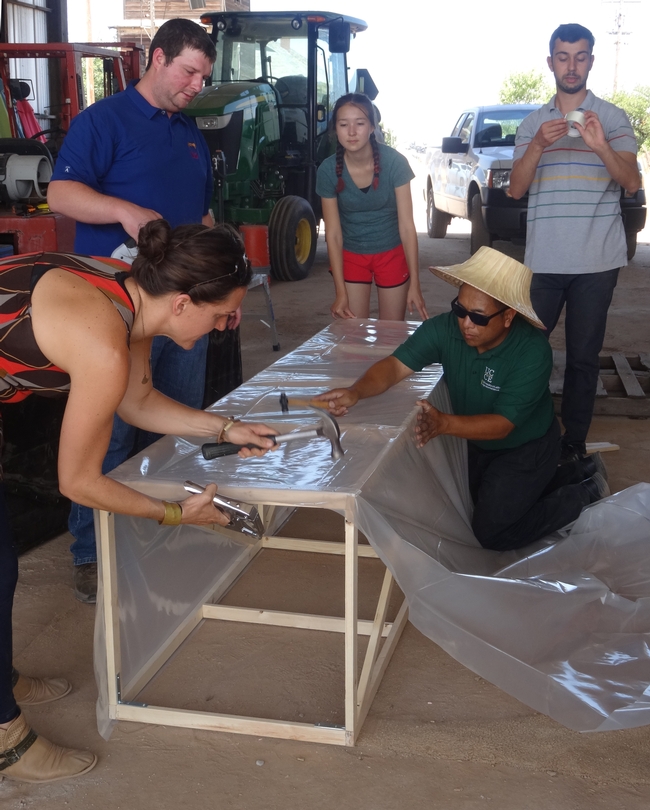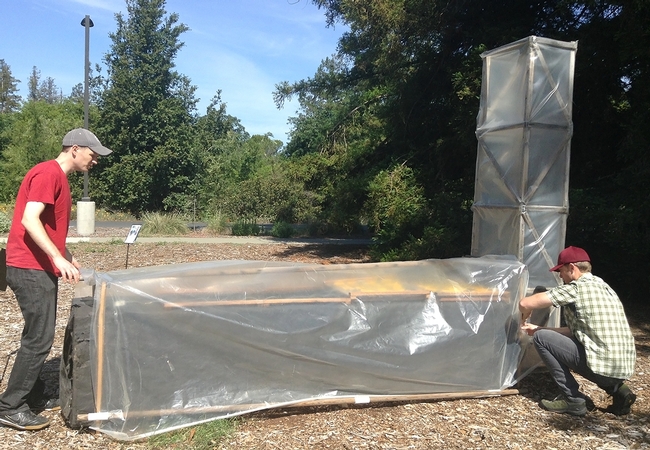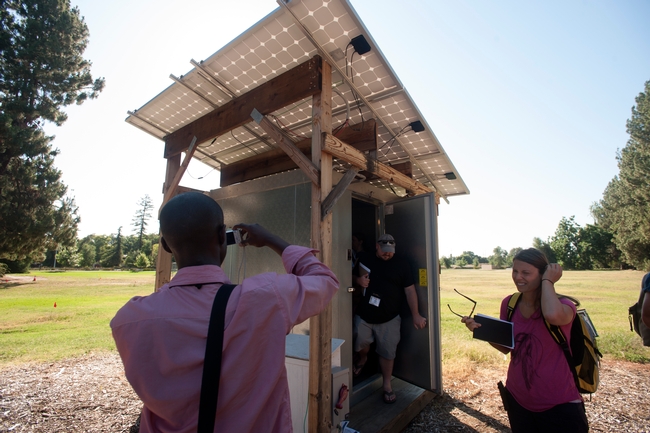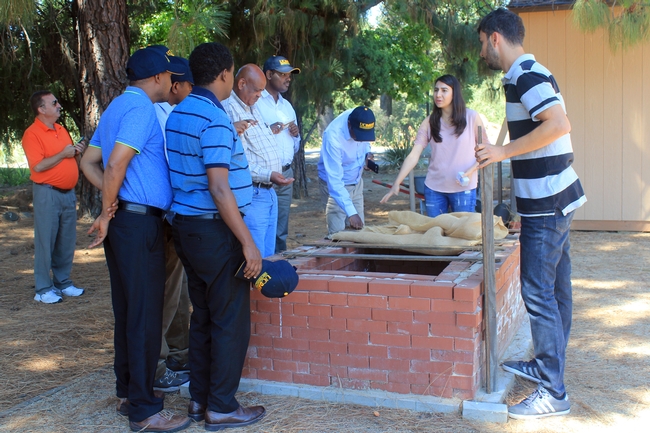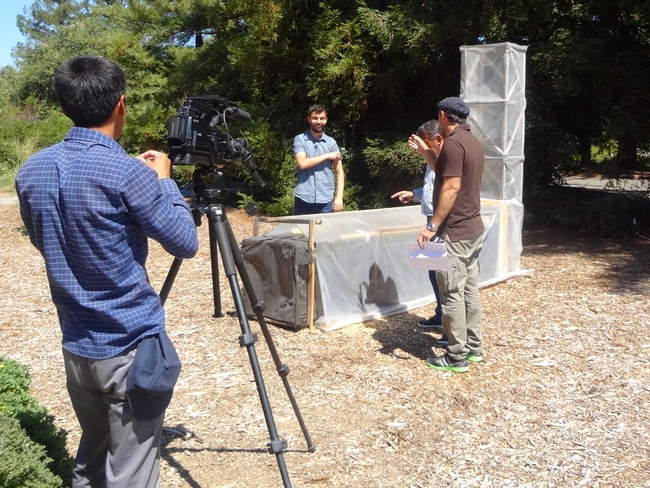
Posts Tagged: cold
Landscaping Tips for November
With the recent time change along with a change in temperatures, landscaping practices for pests...
Ever Seen a Mantidfly?
Ever seen a mantidfly, also called a mantisfly? Bohart Museum of Entomology associate John De...
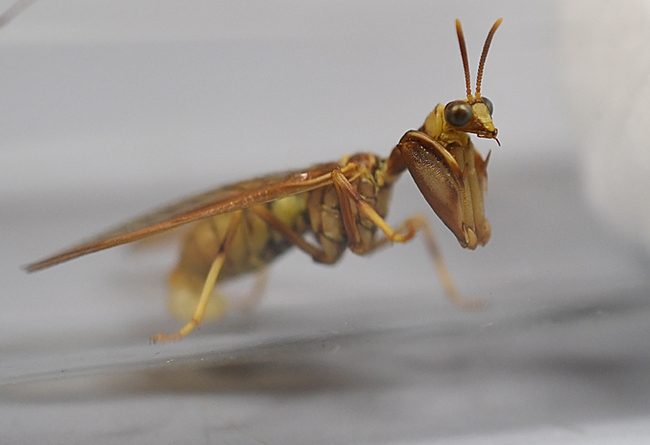
Mantidflies use their front legs to catch small insect prey. This one was collected by John De Benedictis at the UC Davis Stebbens Cold Canyon Reserve. (Snapshot by Kathy Keatley Garvey)
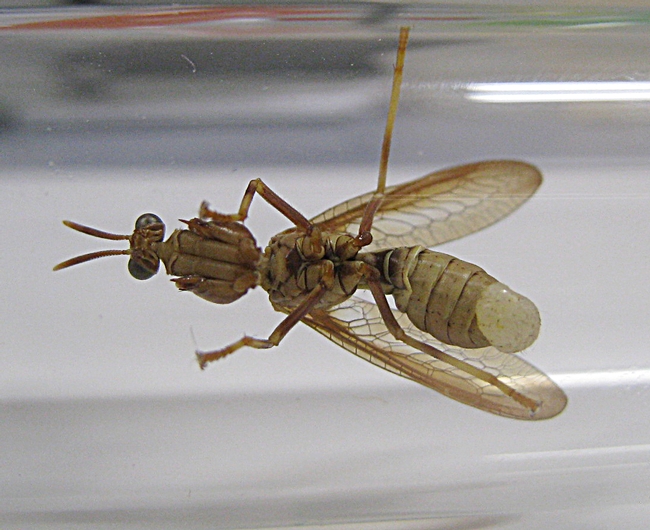
In coloring, the mantidfly abdomen resembles a paper wasp. (Photo by Kathy Keatley Garvey)
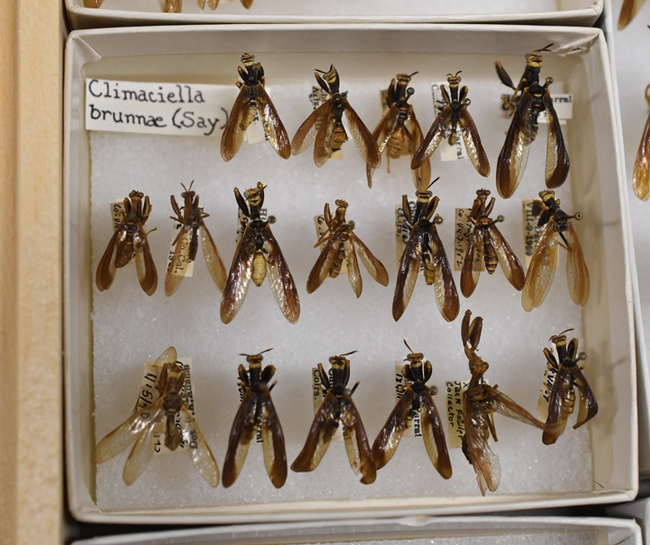
Part of the collection of mantidflies, Climaciella brunnea, at the Bohart Museum of Entomology. (Photo by Kathy Keatley Garvey)
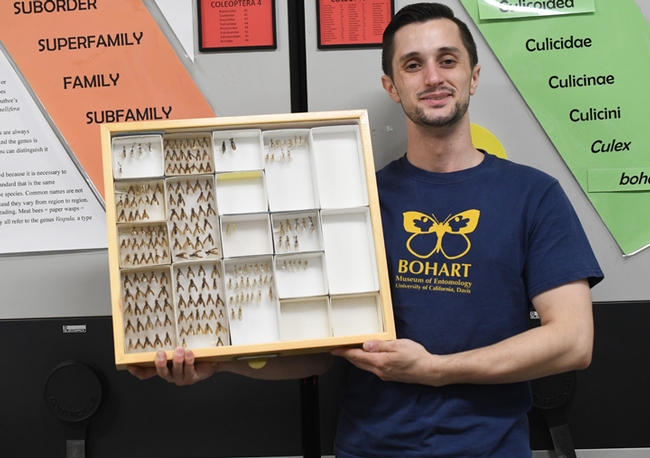
Bohart Museum of Entomology associate Wade Spencer holds a drawer of mantidfly specimens. The museum houses some eight million specimens, collected globally. (Photo by Kathy Keatley Garvey)
Delving Deeper into the Concept of Supplemental Chill
Supplemental chill, also known as cold conditioning, takes place after harvest of the transplants, which have gone dormant because of their exposure to the decreasing daylength and lower temperatures of the nursery fields of Northern California where they are grown. Postharvest supplemental chill occurs in a constant near freezing temperature, in the dark and when the transplant has no to very few leaves left on it.
What supplemental chill is actually doing is breaking (reversing) plant dormancy, which sets into motion a series of metabolic events in the plant resulting in a promotion of vegetative growth and inhibition of new inflorescence formation. Petioles grow longer, leaf blades get bigger and more runners are formed as dormancy is broken through supplemental chill. All of this is consistent with the industry understanding that a longer period of supplemental chill results in more plant vigor, again meaning more vegetative growth and less fruiting. The challenge for the berry grower is to strike a balance between the vigor of vegetative growth and the fruiting which is greatly desired.
Growers already know this, but berry cultivars vary greatly in their sensitivity to the dormancy breaking supplemental chill. Generally speaking, short day strawberry varieties need very little – something on the order of one to three days - to break dormancy and in fact most become tremendously vegetative when chilled in excess over the recommended few days. In contrast, day neutral varieties need substantially more days of chill, most often in the range of one to two weeks, to develop the normal balance of vigor and fruiting following planting. Since longer periods of chill are associated with greater vegetative vigor, organic growers tend to chill their plants longer before planting, in the range of 30% longer, so as to enable the plant to handle less hospitable soil environments.
Strawberry Transplant Cold Conditioning Considerations for the Autumn of 2017
As we creep towards strawberry planting season on the Central Coast, it is always good to review where we stand currently on nursery cold conditioning, and with this in mind, think about adjustments to the post harvest supplementary chill based on what sort of winter we might be expecting.
Those of you who know me understand my faith in hedging my bets and planning for contingencies. I favor decisions with a high probability of success and decent outcomes over swing for the fences with blow your socks off results but missing and failing most of the time. Short supplemental chill times with early planting dates to get the beat on the competition are not my thing since this strategy puts good plant vigor at risk, especially if this 2017-18 winter is warm.
Chill accumulation for this year looks good at the nurseries up at MacDoel. Using Lassen Canyon Nursery's chill accumulation chart (also appreciate the comps to previous years- very useful), shows that, after a warm start in September, hours have really ramped up and currently as of October 5 we are at 337 total hours according to my Utah model calculations (which subtracts chill during warm weather episodes, and discounts temperatures under freezing - look elsewhere on this blog for how I am doing this). That compares very well with previous years, and is in fact ahead of many of them.
Further, looking forward to what sort of winter we are to expect, let's go to the NOAA weather maps. Quite simply, for all of our strawberry production areas, it is as of now 40% probable that we get temperatures above normal this winter (being December, January and February). This is up from 33% a few weeks ago, so I am sensing a trend which seems to confirm where we are headed.
http://www.cpc.ncep.noaa.gov/products/predictions/long_range/lead03/off03_temp.gif
In conclusion, with solid field chill already in the can but a good probability of a warmer than normal winter in the offing, I would again this year favor just a little bit more supplemental chill than customary.
Explore tools that UC researchers use with smallholder farmers around the world
Planted in a corner of the UC Davis campus is a display of technologies and vegetable crops that researchers with the Horticulture Innovation Lab have been using with farmers in Africa, Asia and Central America. Led by UC ANR's Elizabeth Mitcham in the UC Davis Department of Plant Sciences, this program harnesses the agricultural expertise of a network of U.S. university researchers to improve how farmers in developing countries grow fruits and vegetables.
More often than not, the learning goes both ways: Adapting solutions for farmers on another continent can spark ideas that might be useful back home too.
So while the Horticulture Innovation Lab's Demonstration Center was built to showcase international work to campus visitors, you wouldn't be the first to wonder, “Would this technology work on a California farm too?”
Recently a team from UC Cooperative Extension in Fresno County — led by Ruth Dahlquist-Willard, UC Cooperative Extension advisor for small farms in Fresno and Tulare counties — worked with the Horticulture Innovation Lab to learn how to build one of these technologies, to try out with local farmers.
The low-cost technology they built, called a “chimney solar dryer,” combines continuous air flow with solar heat to dry fresh produce more efficiently than a traditional solar dryer. It was designed by the innovative duo Michael Reid and Jim Thompson, both emeritus specialists with UC Cooperative Extension who have worked on multiple inventions with the Horticulture Innovation Lab. The chimney solar dryer is usually built with basic materials, such as plywood, dark plastic, clear plastic, and food-grade mesh. Read more about how the chimney solar dryer can help farmers add value to crop surplus (PDF).
Here is a quick look at a couple of other technologies that visitors can see at the demonstration center:
This solar-powered cold room uses a tool designed by an American farmer, called a CoolBot. In a well-insulated room, a CoolBot can trick a household air conditioner into bringing temperatures down low enough for cool storage of fresh produce. Cooling fruits and vegetables soon after harvest from the field can reduce postharvest losses and extend shelf life. So far teams with the Horticulture Innovation Lab have used the CoolBot with farmers in Tanzania, Zambia, Uganda, Thailand, Cambodia, Bangladesh, India and Honduras.
Read more about how this farmer's invention is reducing postharvest losses around the world.
The zero-energy cool chamber (known as ZECC) is a simple structure built from brick and sand that can help cool fresh produce, in conditions where evaporative cooling is effective. By regularly wetting the sand and brick, farmers or even marketers can keep the temperatures low and the humidity high for fresh produce such as leafy greens. Researchers with the Horticulture Innovation Lab have been testing what specific conditions — such as hot, arid climates with easy access to water — make this tool effective for farmers to use to cool their fresh fruits and vegetables.
More information about the ZECC is available from the UC Postharvest Technology Center.
Recent visits to the Horticulture Innovation Lab's demonstration center have come in many shapes and sizes — from people walking by who stopped to read some of the signs, to group activities planned in advance. Recent tours of the center have included a delegation of deans from agricultural colleges in Ethiopia, a television news crew from Tajikistan and high school students from California learning about innovation and human-centered design.
Next time you're on the UC Davis campus, consider dropping by the Horticulture Innovation Lab demonstration center. You can find it on the campus map, or contact the team for a more focused tour.
Maybe it will spark an innovative idea that you can use in your fields?
More information:
- More recent blog posts about the Horticulture Innovation Lab Demonstration Center
- Explore the African vegetables on display
- Learn more about the technologies on display
- Get updates from the Horticulture Innovation Lab's email newsletter
Led by UC Davis, the Horticulture Innovation Lab is funded by the U.S. Agency for International Development (USAID) as part of Feed the Future, the U.S. government's global hunger and food security initiative.

